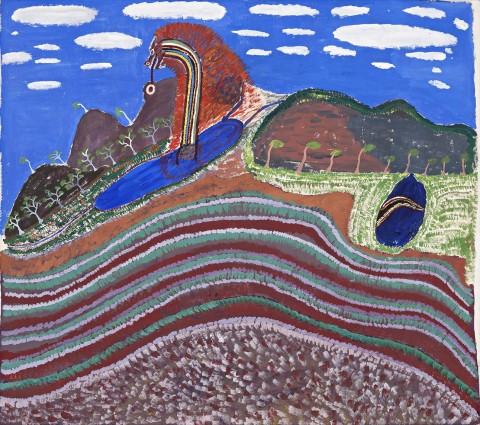GARIMALA, 1989
GINGER RILEY MUNDUWALAWALA
synthetic polymer paint on canvas
154.0 x 174.0 cm
bears inscription verso: Alcaston Gallery cat. GR41 and AK44
Painted at Ngukurr, Northern Territory
Alcaston Gallery, Melbourne
Private collection, Melbourne
Sotheby's, Melbourne, 31 July 2006, lot 96
Private collection, Singapore
Joel Fine Art, Melbourne, 3 June 2008, lot 80
Private collection, New South Wales
Mother Country In Mind: The Art of Ginger Riley Munduwalawala, National Gallery of Victoria, Melbourne, 16 July – 22 September 1997, cat. 11 (label attached verso)
Ryan, J., Ginger Riley, National Gallery of Victoria, Melbourne, 1997, p. 52 (illus., detail)
Garimala (The two snakes), 1988, synthetic polymer paint on canvas, 178.0 x 177.5 cm, in the collection of the Queensland Art Gallery, Brisbane
Garimala, 1990, synthetic polymer paint on paper, 56.8 x 75.5 cm, in the collection of the National Gallery of Victoria, Melbourne, illus. in Ryan, J., Ginger Riley, National Gallery of Victoria, Melbourne, 1997, cat. 33, p. 74
Ginger Riley’s painting recalls his mother’s country; the landscape and mythology relating to the coastal salt-water area adjacent to the Limmen Bight River some fifty kilometres inland from the south-western corner of the Gulf of Carpentaria. His paintings, characterised by a bold use of colour and the recurrence of certain motifs, can be viewed as a sequence of variations upon the same theme. The most often recurring characters are Garimala, the giant Taipan, and Ngak Ngak, the white-breasted Sea Eagle.
Central to this composition, Garimala, the mythological Taipan, is seen emerging from a lagoon in the form of a rainbow, hovering above the country. According to Munduwalawala's story, Garimala created the Four Archers, an area regarded as ‘... the centre of the earth, where all things start and finish’1 and where the snake lives in the waterhole close by. The story continues that Garimala ‘travelled from the Four Archers to Nyamiyukanji in the Limmen Bight River, disappeared under the water and metamorphosed into the Rainbow’.2 As the rainbow, Garimala is associated with the life-giving properties of fresh water, the monsoon season and the continuing cycle of life.
Although distinguished by the endurance of a singular narrative, Riley's iconography is not restrictive, nor is there a lack of innovation. Rather, the repetition of his mother’s stories allows for a greater depth of exploration and reinvention. Riley employed bold colour, dramatic variations in scale and unusual spatial arrangements for visual impact. His colour choices were particularly daring and unexpected, intense colour contrasts and silhouetting enabled images to stand out as well as being used to animate and give energy to the story. His technique and aesthetic were truly unique and changed expectations of what characterised Aboriginal painting.
1. Ryan, J., Ginger Riley, National Gallery of Victoria, Melbourne, 1997, p. 29
2. ibid., p. 30
CRISPIN GUTTERIDGE
